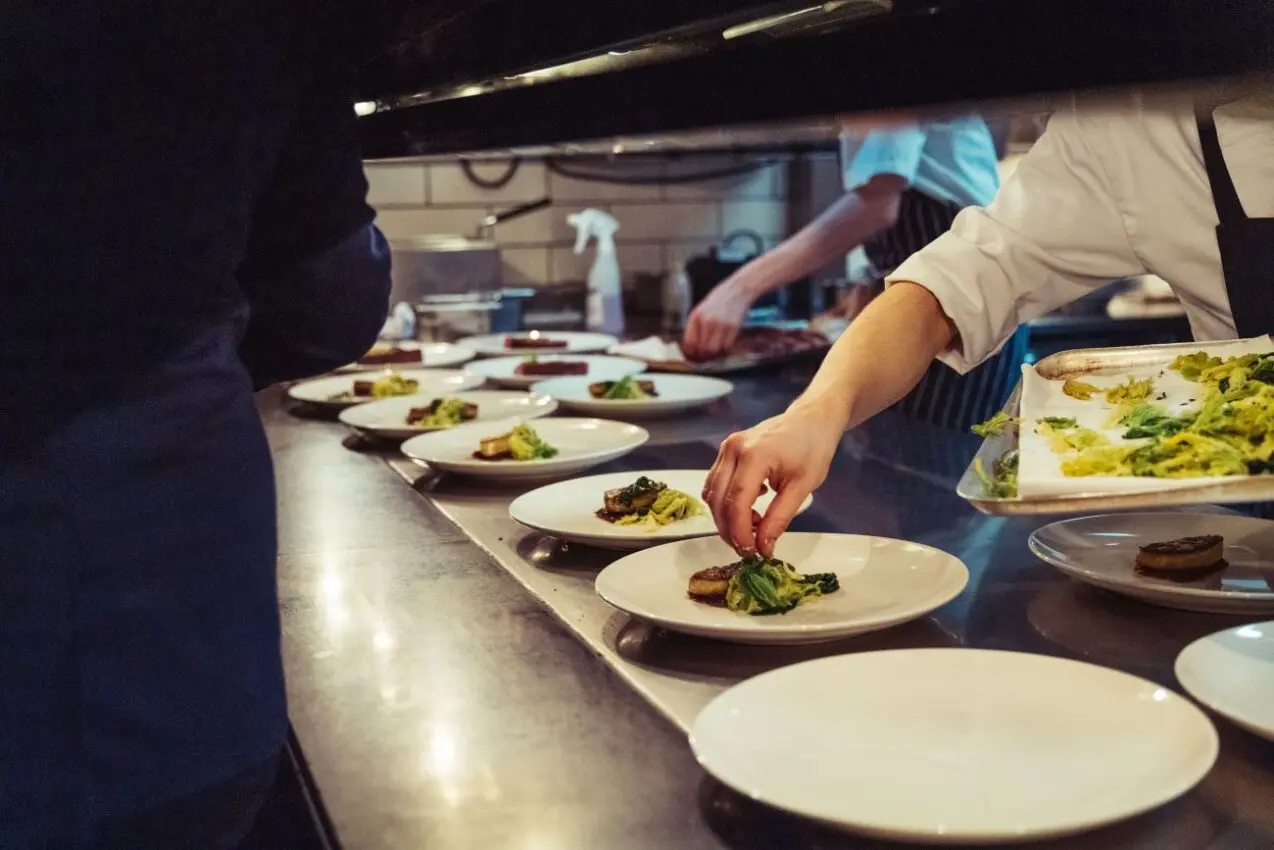If you love food, the Michelin-starred restaurants in Los Angeles are a must-visit. Los Angeles proudly flaunts 19 one-star and 5 two-star Michelin restaurants. These top-tier places promise memorable dining for locals and visitors alike.
Providence impresses with its two Michelin stars and focus on sustainable seafood. Chef Michael Cimarusti amazes with dishes like Pacific oyster and lobster canapés, not to mention the celebrated uni egg with champagne beurre blanc. Seafood enthusiasts will find their haven at 5955 Melrose Ave.
At n/naka, Chef Niki Nakayama’s Japanese kaiseki creations reference both Japanese tradition and a Californian setting. Together, these five two-starred restaurants cement Los Angeles’ reputation as a pioneer on the global fine dining stage. They are must-visits for food-focused travelers while pleasing well-heeled locals.
Even one-starred establishments punch far above their weight class. Destination dining aside, these nimbler restaurants best epitomize L.A.’s range and diversity. Their more approachable settings and prices entice neighborhood regulars and first-time visitors alike.
The French tire company Michelin launched its restaurant grading scheme in 1926 as an amenity for motorists. Star ratings highlighted worthy roadside hotel restaurants peddling regional fare. Since then, Michelin recognition has become synonymous with world-class fine dining.
Despite launching its first California guide a decade ago in San Francisco, Los Angeles had to wait until 2019 to garner Michelin's attention. That initial Los Angeles guide awarded stars to 23 restaurants, with Providence claiming two-star honors. This number has held steady, with the same 5 restaurants keeping two stars year to year.
These restaurants remain distinctive enough to trade on the prestige of two Michelin stars alone. Their wider reputations attract celebrity diners alongside deep-pocketed out-of-towners. Locals rank meals here as special occasion territory. Yet familiarity with these lauded chefs also breeds affection, keeping the restaurants in their neighborhoods.
Seafood shines brightest among Los Angeles’ starred restaurants, showcasing both sustainability and sheer excellence. It makes sense, given the city occupies a long stretch of Pacific coastline. Seasonal catches and aquaculture harvests from Santa Barbara to Baja California supply local kitchens daily.
Providence earns two Michelin stars for Chef Michael Cimarusti's singular creations arising from that bounty. Cimarusti enumerates seafood varieties to their precise subspecies, then transforms them into French-inflected bites conveying subtle flavor variations. Textural contrasts add intrigue, like the champagne beurre blanc clinging to lobster canapés.
Over in Santa Monica, Mélisse upholds two Michelin stars for its stunning rendition of seafood within a progressive French context. Diver scallops from Santa Barbara marry with black winter truffles in one iconic dish. Alaskan king crab enriches a frothy soup crowned with osetra caviar. Chef Josiah Citrin embraces Los Angeles’ seasonal produce while importing luxury ingredients when appropriate.
This technical ability with global ingredients dazzles. But Los Angeles holds enough virtue on its own, as other starred restaurants demonstrate. Nancy Silverton sources most ingredients for Osteria Mozza’s Italianate small plates locally to resounding success. Her legendary fresh-made mozzarella and burrata alone justify splurging at the Hollywood and Newport Beach locations.
Niki Nakayama's n/naka offers Japanese kaiseki cuisine firmly rooted in California soil, from the vegetables grown on-site to line-caught seafood. Smoked and grilled preparations coax out subtleties in the best local produce. Chef Noah Sandoval previously completed a stage at n/naka, later incorporating its ethos of regionality at his own restaurant, Otium. There, diners enjoy sprouted lentils from Cayuga Pure Organics dressed in satsuma-infused vinegar. This shared reverence for native ingredients will likely inform Los Angeles’ fine dining trajectory going forward. Sourcing directly from regional farmers, ranchers and fishers keeps restaurants linked to L.A’s terroir - and its ongoing seasons.
Earning an inaugural star marks entry into the fine dining firmament proper. It also pressures chefs to double down on excellence to gain a second star or keep hold of one. Elite dining at these restaurants interleavens reward with just enough risk to quicken the pulse.
Los Angeles leaves plenty of options with 19 one-star establishments spanning Silver Lake to Manhattan Beach. Idaho trout melts under sage butter sauce at Simone; wavy housemade buckwheat tagliatelle wraps around ragu at Pasta|Bar; A5 Japanese wagyu grilled over bincho charcoal at Musha—each restaurant gifts diners a dream version of familiar dishes or ingredients.
Others are one-star darlings who challenge preconceptions completely. Sushi Inaba upholds edomae tradition within a discreet 10-seat sushi bar in Torrance: pristine fish imported from Japan molded gently over temperature-controlled rice with warm hands. Nearby, Kato's spicy Szechuan peppercorns and chilies electrify delicate sliced flounder, banishing assumptions that Chinese food spins only from Cantonese or American-style menus.
These restaurants broadcast the sheer variety enveloped under Los Angeles’ culinary umbrella. Their modest size and pricing also render one-star dining more accessible every day than costly tasting menus at two-star venues.
Consider Kali, the Hollywood restaurant where Chef Kevin Meehan prepares seasonal vegetable degustations inside a cozy 28-seat dining room. While dishes like smoked potato cooked in garbanzo bean dashi certainly tantalize, Meehan also offers creative small plates for grazers who prefer to avoid lingering. When applied at a more casual strata, this balance of fine dining techniques echoes across many of L.A.’s one-star establishments.
Add to that the city’s exceptional cocktail and wine programs: Regi Mathew’s extensive Madeira selections at The Arthur J; sommelier Hande Vriesman Besikcioglu's envelope-pushing Eurocentric pairings for Orsa & Winston. Los Angeles one star venues feel quintessentially of their city, keeping apace on parallel tracks aside from just singular cuisine. Dining at this tier promises not just outstanding food, but an elevated experience synthesizing setting, service, wine, and campus too.
For destinations like Los Angeles that are already basking in culinary esteem, Michelin rankings mostly validate existing reputations. Earning that first star represents hard-won recognition of a restaurant's virtues. Stars two and three shift closer to holy grails—still attainable for the city’s brightest talents but distant.
Critics debate the utility of Michelin stars, especially abroad, relative to local dining cultures. Yet for Los Angeles, even one star holds formidable weight within an exceptionally crowded field. Thousands of restaurants blanket the city landscape, centered within distinct ethnic enclaves, spanning food trucks to mall food courts. Standing out is no mean feat.
So Michelin provides clarity for visitors hungry to pinpoint high-end restaurants amid the clamor. Noteworthy gaps do exist - no-starred Mexican restaurant despite Los Angeles’ Latin American influences and population. However, star designations mostly highlight already respected venues; Providence and Mélisse ruled as special occasion darlings well before Michelin arrived.
One star indicates a consummate neighborhood gem at the neighborhood level - Simone in Silver Lake, Kato in Downtown’s banking district. Stars reference classical Eurocentric precedent, with sushi bars and Chinese flavors filtered through a Western-adjacent lens. Even so, Michelin makes dining decisions easier for tourists and locals by sorting wheat from chaff.
Moreover, it gives the city itself a renown boost. San Francisco and Chicago may claim more starred restaurants overall, but Los Angeles leads for diversity. From intricate sushi conveyor belts to open-fire grilling, intimate pasta halls to sprawling mansions housing haute cuisine, not even New York City matches that range. This sustains L.A.’s reputation as a global culinary innovator rather than a mere hub for health fads.
With Michelin affirming its merits year after year, Los Angeles now faces expectations to keep raising its game. Perhaps in the years ahead, more local restaurants will reach rarefied two—or three-star status—or new benchmarks will be created altogether.

 Israeli attorney general orders probe into report that alleged Netanyahu's wife harassed opponents
Israeli attorney general orders probe into report that alleged Netanyahu's wife harassed opponents
 Peru declares environmental emergency after oil spill
Peru declares environmental emergency after oil spill
 The strike against Amazon is over but Teamsters warn: ‘Stay tuned’
The strike against Amazon is over but Teamsters warn: ‘Stay tuned’
 Bad Bunny announces a new album, 'Debí Tirar Más Fotos'
Bad Bunny announces a new album, 'Debí Tirar Más Fotos'
 Column-Why US Congress restored Social Security benefits for public-sector retirees: Mark Miller
Column-Why US Congress restored Social Security benefits for public-sector retirees: Mark Miller
 Miami Hurricanes men’s head basketball coach Jim Larrañaga steps down, cites NIL: ‘I’m exhausted’
Miami Hurricanes men’s head basketball coach Jim Larrañaga steps down, cites NIL: ‘I’m exhausted’
 Penn State offensive coordinator Kotelnicki's creativity has the Nittany Lions humming in the CFP
Penn State offensive coordinator Kotelnicki's creativity has the Nittany Lions humming in the CFP
 Discover the best Los Angeles Michelin Star Restaurants. Our guide showcases the city's finest dining experiences, from exquisite cuisine to top chefs.
Discover the best Los Angeles Michelin Star Restaurants. Our guide showcases the city's finest dining experiences, from exquisite cuisine to top chefs.






